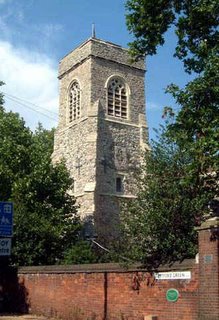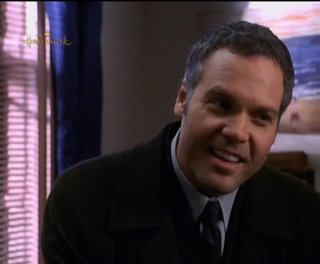Welcome to the world of the Vincent D'Onofrio obsessed - and a bit of real life thrown in.
Saturday, June 24, 2006
Palace of Versailles
 Part of the Palace reflected in one of the water features.
Part of the Palace reflected in one of the water features.
Louis XIV of France wanted to build a palace fit for an Absolute Monarch. The result was Versailles. It had a theatre as well as a chapel, and in the grounds a lake to rival Hampton Courts. There was also a pair of smaller palaces, the Grand Trianon for the King and the Petit Trianon for the Queen. The gardens were full of water features, but there wasn't enough water to run them all at once, so the gardeners would run around frantically trying to anticipate where the King would go on his walks, and turn fountains on and off as he went.
The Hall of Mirrors has been the scene of treaties and important international meetings over the centuries.
Louis XVI's wife, the notorious Marie Antoinette, spent much of her life playing at being a shepherdess. She would drive her flock of sheep across a rustic bridge to a small hamlet built near her small palace, where there remain all sorts of little thatched buildings, including a mill.
Versailles or Hampton Court? Versailles is a composition of the Seventeenth and Eighteenth Centuries, with more of an overall conception. Hampton Court is the result of innumerable additions (and subtractions) over hundreds of years.
Hampton Court Palace
It was developed over the next couple of hundred years, in the styles of the various eras.
Under WIlliam and Mary Sir Christopher Wren supervised some further development, and the Tudor and Stuart wings make this a palace of many faces.
The Palace used to contain "grace and favour" appartments, where retired ladies-in-waiting and other distressed gentry could live. One batty old bag would only use candles and, yes, you've guessed it, she managed to set fire to the place. The repair and renovation took years, but in the process some lost features, such as the King's Privy Garden, were rediscovered and have now been reinstated. Sadly, though, many works of art were lost of damaged. The madwoman was the only human casualty.
 A close-up of the West Front portico. Don't know who circled themselves.
A close-up of the West Front portico. Don't know who circled themselves.
 A bird's eye view of part of the palace.
A bird's eye view of part of the palace.
 The Astronomical Clock. It only has an hour hand.
The Astronomical Clock. It only has an hour hand.
 The Tudor Kitchens.
The Tudor Kitchens.
 Wren's South Front.
Wren's South Front.Goren at the Rubber Factory
Friday, June 23, 2006
Three Churches in Deptford, South East London
 '
'
 St Paul's
St Paul'sSt Luke's
St Nick's has a memorial to Peter The Great, Tsar of Russia, who, in the 17th century, lived nearby with the diarist John Evelyn at his posh house, Sayes Court. He famously wrecked the hedges by having himself pushed through them in a wheelbarrow! (He was 6'7" so he would have made a big impression...) He came to Deptford to learn the art of shipbuilding. It was an important place back then. Elizabeth I knighted Walter Raleigh there. The playwright Christopher Marlowe was murdered in The Globe Tavern in what is now known as Evelyn Street. My school was part founded by shipbuilder John Addey, a man who was instrumental in bringing Peter to London, so we used to hold Founder's Day services in St Nick's.
St Paul's was built in the early 1700s by Thomas Archer and was described by the poet John Betjeman as "a pearl in the heart of Deptford". It is a truly elegant church, and puts to shame some of the lumpier examples from the same period that you can also see on a trip on the Docklands Light Railway. I was baptised in St Paul's in 1953. A few years ago I returned to sing at a wedding there.
St Luke's is a more pedestrian Victorian offering. It's back-to-front, with the apse facing the street. It's like going in by the back door. Three generations of my family married in the church, going back 100 years.
Thursday, June 22, 2006
The Cutty Sark again
Blogger is playing silly games
 Here am I, trying to do one of my educational posts, and blogger will only post this photo. Over and over again, no matter which one I highlight. I want to give you the Cutty Sark, a tea clipper in dry dock in Greenwich (the home of the zero degrees meridian). It's nearly 140 years old, and was once the fastest vessel doing the tea run from the east.
Here am I, trying to do one of my educational posts, and blogger will only post this photo. Over and over again, no matter which one I highlight. I want to give you the Cutty Sark, a tea clipper in dry dock in Greenwich (the home of the zero degrees meridian). It's nearly 140 years old, and was once the fastest vessel doing the tea run from the east.This is the prow of the ship with its figurehead. Cutty Sark is a character from a Robbie Burns poem.
I'l try later to get some more pictures to post.
Bill, Ben and Mitzi
It's new to me
Wednesday, June 21, 2006
Well-endowed
Tuesday, June 20, 2006
Eltham Palace
The new house is not the prettiest 1930s place you'll ever see - on the outside. Inside it is glorious, with woods used to magnificent effect, and all sorts of mod cons, like a central vacuum cleaning system and piped music.
After the war the Courtaulds left to go to South Africa, and gave the Palace to the Army, which housed its education department there for the next 50 years or so. It was then handed back to the nation, and English Heritage set about restoring it. It is now a very popular place to visit, both for its fabulous interiors and its gorgeous grounds, where some portions of the old Tudor palace walls can still be seen. There's a great little restaurant where you are served by "nippies", a type of waitress found in Lyons Tea Rooms from the pre-war period right into my lifetime.
If you ever have the chance, go and visit. Eltham is a south eastern suburb of London.
 Part of the garden and the new house, with a portion of Tudor red brick wall and medieval stone wall.
Part of the garden and the new house, with a portion of Tudor red brick wall and medieval stone wall. The exterior of the medieval Great Hall. The palace was well known to Henry VIII and the first Elizabeth.
The exterior of the medieval Great Hall. The palace was well known to Henry VIII and the first Elizabeth. The hammer-beam roof in the Great Hall.
The hammer-beam roof in the Great Hall. The inside of the dining room doors.
The inside of the dining room doors. The dining room fireplace.
The dining room fireplace. Replica furniture in the dining room
Replica furniture in the dining room Virginia Courtauld's bedroom.
Virginia Courtauld's bedroom. Ginny's bath.
Ginny's bath. The entrance hall, with marquetry scenes leading from the doors to the staircases.
The entrance hall, with marquetry scenes leading from the doors to the staircases.


































